+91 858 886 6045
Indian Maharaja Express
Indian Maharaja Express - Deccan Odyssey offers 7 Nights/ 8 Days tour. The train starts from Delhi to Mumbai and Mumbai to Delhi on every Wednesday of the week.
Optional return flight from Mumbai to Delhi is also available.
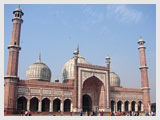 Day 1 - Wednesday: Departure Delhi
Day 1 - Wednesday: Departure Delhi
In the morning, welcome meeting at hotel. Later, proceed for sightseeing of Delhi with lunch at city hotel.
Delhi: India&euro™s capital and a major gateway to the country, contemporary Delhi is a bustling metropolis, which successfully combines in its folds - the ancient with the modern. Amidst the fast spiraling skyscrapers the remnants of a bygone time in the form of its many monuments stand as silent reminders to the region&euro™s ancient legacy. The first impressions for any visitor traveling in from the airport are of a specious, garden city, tree-lined with a number of beautiful parks.
You will first visit Old Delhi. The tour will begin with a visit to Raj Ghat, a simple memorial to Mahatma Gandhi; drive past the Red Fort - a world heritage site, continuing to the Jama Masjid, It is the largest mosque in India, accommodating up to 25,000 worshippers at one time.
The tour to Imperial Delhi will include a visit to the Qutub Minar, the tallest stone tower in India. Qutub-ud-din Aibak started it in 1199. Pulling down 27 Hindu and Jain temples and using their columns erected the attached Quwwat-ul-Islam mosque also built by him. The tour also includes a photo stop at the imposing India Gate, the Parliament building and the Rastrapathi Bhawan, the President&euro™s residence.
Evening proceed to railway station for check-in.
Dinner on board and then depart for Bharatpur (Agra). Overnight onboard train.
Day 2 - Thursday: Agra
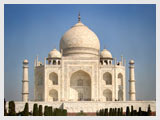 After breakfast on board the train, drive to Agra visiting Fatehpur Sikri enroute.
After breakfast on board the train, drive to Agra visiting Fatehpur Sikri enroute.
Fatehpur Sikri - the deserted red sandstone city, built by the Great Mughal Emperor Akbar as his capital and palace in the late 16th century. It was abandoned soon after it was built when the local wells went dry and it remains today in much the same condition that it was over 300 years ago. It is complete with palaces and mosques and used to be a town larger than London when it was originally constructed. Now it is an extraordinary place to wander around with its buildings in near perfect condition.
Agra in terms of ambiance is still associated with its Mughal period. The Mughals besides being great rulers were also great builders and they preserved their best architectural wonders for Agra & its neighborhood.
Later visit Taj Mahal. The Taj Mahal is everything that has been said about it and more. Taking 22 years and 20,000 men to build, the white marble was quarried 200 miles away and was transported to the site by a fleet of 1000 elephants. Built by the Mughal Emperor Shah Jahan as an expression of his love for his wife Mumtaz Mahal, in mid 17th century, the Taj Mahal is truly one of the wonders of the world.
Visit Agra fort. Agra Fort, an outstanding example of Mughal architecture. Agra Fort - the seat and the stronghold of the Mughal Empire under successive generations. This was the seat of Mughal rule and administration and the present structure owes its origins to Akbar who erected the walls and gates and the first buildings on the eastern banks of Yamuna River. Shah Jehan added the impressive quarters and the mosque while Aurangzeb added the outer ramparts. Visit its Hall of Public Audience and its Royal Pavilions.
Lunch, dinner and overnight on board. The train leaves for Jaipur.
Day 3 - Friday: Jaipur
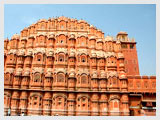 Jaipur's past is never too far from hand. The city of victory, Jaipur presides over the fascinating desert state and its people: surrounded by rugged hills, each crowned by a formidable fort; and beautiful palaces, mansions and gardens dotted throughout its precincts. The palaces and forts of yesteryear that were witness to royal processions and splendour are now living monuments, accepted quite naturally into the lifestyles of the people of the "pink city". Except for the busy traffic of bicycles, cars and buses, little seems to have changed.
Jaipur's past is never too far from hand. The city of victory, Jaipur presides over the fascinating desert state and its people: surrounded by rugged hills, each crowned by a formidable fort; and beautiful palaces, mansions and gardens dotted throughout its precincts. The palaces and forts of yesteryear that were witness to royal processions and splendour are now living monuments, accepted quite naturally into the lifestyles of the people of the "pink city". Except for the busy traffic of bicycles, cars and buses, little seems to have changed.
After breakfast on board, you will be driven just outside Jaipur to the ancient capital of Amber to see the fabulous Amber Fort. Maharaja Mansingh, Mughal Emperor Akbar&euro™s most successful General, started the construction of Amber Fort in the 17th century.
Before the City Palace was constructed in Jaipur, Amber was the seat of power. The fort is surrounded by fortified battlements and overlooks the Moat Lake. Ruins and remains are spread over the Aravalli hills and sprawling crenulated walls lattice the surrounding area.
An elephant (alternatively by jeeps) will spare you the trouble of reaching up to the fort. Once on top, stroll through the sprawling complex of courtyards and halls. Many of the rooms have delightful wall paintings, with precious stones and mirrors inlaid in the walls. Most fascinating, perhaps, is the Sheesh Mahal (hall of mirrors) where a single lamplight is reflected in the many mirrors, lighting up the room.
Travelling back to main city, you will stop and see the `Palace of Winds&euro™, otherwise known as Hawa Mahal. It is really an elaborate facade behind which the ladies of the court used to watch the daily goings on in the street below. It is extremely intricate in its pink sandstone carving. The cool wind blows through its facade of windows and latticed screens through which the queens of the court once viewed the streets of the city.
In the afternoon, you will visit the city of Jaipur. Among the highlights to be seen while touring Jaipur include the City Palace, which is an overwhelming complex of exquisite palaces, gardens and courtyards, decorative art and carved doorways. The palace museum houses collections of rare manuscripts, armoury, costumes, carpets and miniature paintings. Walk to the adjacent Jantar Mantar or Astronomical Observatory made by the Maharaja of Jaipur, built in 1726 and is one of the five such astronomical wonders built by Sawai Jai Singh and makes accurate predictions even to this day. You will also have the opportunity to wander about the local markets.
Lunch and Dinner on board train. Train leaves for Sawai Madhopur on overnight journey.
Day 4 - Saturday: Sawai Madhopur
 Early morning Jungle Safari at Ranthambhore National Park. Near the township of Sawai Madhopur, in the state of Rajasthan, Ranthambhore National Park is an outstanding example of Project Tiger&euro™s efforts at conservation in the country. The forests around the Ranthambhore Fort were once, the private grounds of the Maharajas of Jaipur. As a result of the stringent efforts in conservation, tigers, the prime assets of the Park, have become more and more active during the day. More than in any other park or sanctuary in India, tigers are easily spotted here in daylight. It is very easy to chance upon a tiger lolling around lazily in the sun, or feverishly hunting down Sambhar around the lakes.
Early morning Jungle Safari at Ranthambhore National Park. Near the township of Sawai Madhopur, in the state of Rajasthan, Ranthambhore National Park is an outstanding example of Project Tiger&euro™s efforts at conservation in the country. The forests around the Ranthambhore Fort were once, the private grounds of the Maharajas of Jaipur. As a result of the stringent efforts in conservation, tigers, the prime assets of the Park, have become more and more active during the day. More than in any other park or sanctuary in India, tigers are easily spotted here in daylight. It is very easy to chance upon a tiger lolling around lazily in the sun, or feverishly hunting down Sambhar around the lakes.
All meals on board the train.
Afternoon Jungle safari. (The jungle safaris will be by canter)
Overnight on board the train which leaves for Udaipur on an overnight journey.
Day 5 - Sunday: Udaipur
Breakfast on board. Later proceed for sight seeing at Udaipur 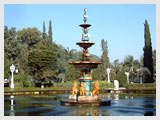 Set on the shores of Lake Pichola and surrounded by hills, Udaipur grew in complete contrast to the harsh deserts of the rest of Rajasthan. As capital of the old Mewar State it was the only Rajput stronghold to uphold its Hindu allegiance in the face of Muslim invasion. From the late 16th century, peace brought about an era of renaissance in the arts and encouraged the building of beautiful palaces around the lake, culminating in the City Palace, one of the largest palace complexes in the world. The lake itself is a romantic setting surrounding the gleaming white Lake Palace and the Jag Mandir, a refuge of the rebel Mughal prince, Shah Jahan, soon to be the creator of the incomparable Taj Mahal.
Set on the shores of Lake Pichola and surrounded by hills, Udaipur grew in complete contrast to the harsh deserts of the rest of Rajasthan. As capital of the old Mewar State it was the only Rajput stronghold to uphold its Hindu allegiance in the face of Muslim invasion. From the late 16th century, peace brought about an era of renaissance in the arts and encouraged the building of beautiful palaces around the lake, culminating in the City Palace, one of the largest palace complexes in the world. The lake itself is a romantic setting surrounding the gleaming white Lake Palace and the Jag Mandir, a refuge of the rebel Mughal prince, Shah Jahan, soon to be the creator of the incomparable Taj Mahal.
Visit the vast and exquisite City Palace, a well-fortified, majestic white monument. The main entrance, a triple-arched gate named the Tripolia, was built in 1725 and is a marvel. The Suraj Gokhada, the Balcony of the Sun, where the Suryavanshi Maharanas of Mewar presented themselves in times of trouble to the people to restore their confidence, is also a fascinating sight. Also visit the Cristal Gallery.
Lunch on board the train.
Drive past Fateh Sagar Lake; visit Sahelion-ki-Bari, the Garden of the Maids-of-Honor, which has numerous fountains in four pools, embellished with delicately chiseled kiosks and elephants. The garden brings to the fore the unique lifestyle of the royal ladies, who once strolled through these gardens. Continue to visit Jagdish Temple, a 16th-century temple dedicated to Lord Vishnu, it is the largest and most splendid temple in Udaipur.
In the evening take a cruise on Lake Pichola to visit Jag Mandir Palace, which covers almost four acres and is noted for its marble pavilion and an imposing dome. You&euro™ll see people doing their laundry on the shores of the lake against the backdrop of the massive City Palace and the old city. (boat ride subject to water levels in the lake)
Special dinner at city hotel. Return to train which leaves for Ahmadabad during the night.
Day 6 - Monday: Ahmedabad
After Breakfast sight seeing at Ahmedabad.
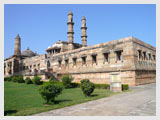 Emperor Jehangir sneered that Ahmedabad was actually Gardabad (The City of Dust). But one must also remember that the 17th century Muslim historian Muhammad Qasim Firishta said that it was on the whole, the handsomest city in Hindoostan. Both statements contain a grain of truth. Ahmedabad is a dusty, noisy, chaotic city. It is also very beautiful, its mosques marked with delightful minarets, elaborate tracery and infinite attention to detail. It is a remarkably secular city with a history of religious harmony that has only been marred by a few unsavory incidents in the late 20th century.
Emperor Jehangir sneered that Ahmedabad was actually Gardabad (The City of Dust). But one must also remember that the 17th century Muslim historian Muhammad Qasim Firishta said that it was on the whole, the handsomest city in Hindoostan. Both statements contain a grain of truth. Ahmedabad is a dusty, noisy, chaotic city. It is also very beautiful, its mosques marked with delightful minarets, elaborate tracery and infinite attention to detail. It is a remarkably secular city with a history of religious harmony that has only been marred by a few unsavory incidents in the late 20th century.
You will first visit Teen Darwaza - a triple gateway 37 feet high built by Sultan Ahmed. From here the Sultans watched the processions from the palace to the Jama Masjid. Your next stop would be Jamma Masjid &euro“ which is one of the biggest and oldest mosques for Friday prayers. Built by Sultan Ahmed Shah in 1423, the mosque is situated in the centre of the old city. It is one of the finest mosques in India with 260 pillars supporting 15 domes at different elevations. You will also visit Shaking minarets & Jain Temple.
Lunch, dinner and overnight on board train. Train leaves for Jalgaon in the evening.
Day 7 - Tuesday: Aurangabad
Early morning arrive in Jalgaon.
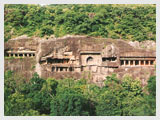 Breakfast on board. Then leave by bus to Ajanta (55 kms / 1 ½ hrs). Train will move on without the guests to Daulatabad.
Breakfast on board. Then leave by bus to Ajanta (55 kms / 1 ½ hrs). Train will move on without the guests to Daulatabad.
Famous for its caves, Ajanta is one of the few historical and architectural marvels of India. Recognised as the World Heritage site today, it was discovered during the 19th century by a group of British officers who were on a tiger hunt. The Ajanta group of caves, located deep within the Sahyadri hills above the Waghora, depict the story of Buddhism that prevailed here during 200 BC to 650 AD.
Then drive to Aurangabad for lunch at city hotel (100 kms/3 hrs).
Sightseeing of Aurangabad visiting Bibi Ka Maqbara , Panchakki. Bibi Ka Maqbara - Modelled on the Taj Mahal, Aurangabad's Mughal tomb garden was built by Prince Azam Khan in memory of his mother, Begum Rabia Daurani. Panchakki , the word Panchakki literally means water mill. It is another major attraction of Aurangabad. The mill gets its share of water that travels through an underground channel from a source which is 6 km away in the mountains. The water is released on to the wheel creating an enthralling waterfall. The place also has a garden and fountains with fish-filled tanks enhancing the beauty of the entire area.
Transfer to Daulatabad (15 kms/30 mnts). Upon arrival board on train. Dinner on Board.
Later evening departure for Mumbai on an overnight journey.
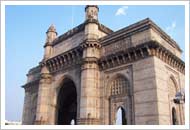 Day 8 - Wednesday: Leave Mumbai
Day 8 - Wednesday: Leave Mumbai
Morning - Arrival at CST - Mumbai. Journey Ends. Enjoy the breakfast on board as the sun rises over the commercial capital of India. Alight at the Chhatrapati Shivaji Terminus in the morning enriched with the rich legacy of this land. The royal journey is over, but the memory of which, will live on forever.
Journey ends
Optional return flight from Mumbai to Delhi is also available.
Tajmahal Tours
Golden Triangle India
- Golden Triangle with Corbett
- Golden Triangle with Goa
- Golden Triangle with Kathmandu
- Golden Triangle with Wildlife
- Indian Heritage Tour with Tajmahal
- Buddhist Pilgrimage with Golden Griangle Tour
- Golden Triangle Tour
- Golden Triangle Tour with Haridwar and Rishikesh
- Golden Triangle with Khajuraho Varanasi
- Golden Triangle with Kashmir
- Tajmahal with Pushkar Fair
Delhi Tourism
Jaipur Tourism
Agra Tourism
Golden Triangle Extension
- Ranthambhor National Park
- Khajuraho Tourism
- Varanasi Tourism
- Rishikesh Tourism
- Haridwar Tourism
- Corbett Wildlife Sanctuary
- Mathura Travel
- Vrindavan Travel
- Gwalior Travel
Activities to Do


Copyright © 2020, www.tajmahal-india-tours.com
Recognized by Ministry of Tourism, Government of India
National Tourism Award Winner
Powered by SOFTTIX

